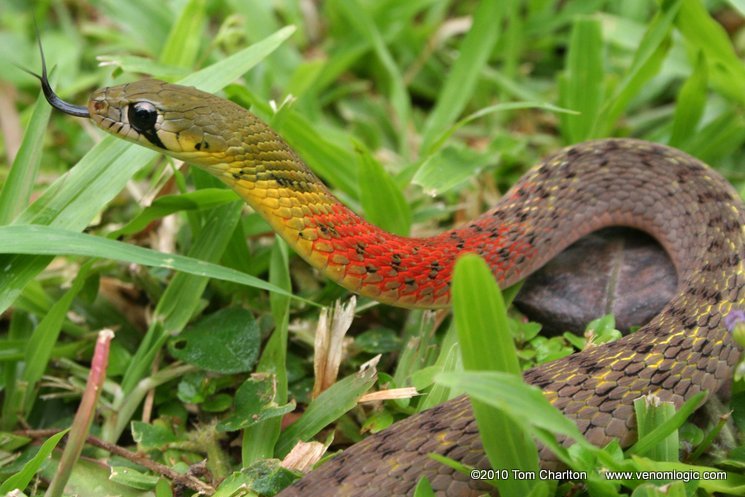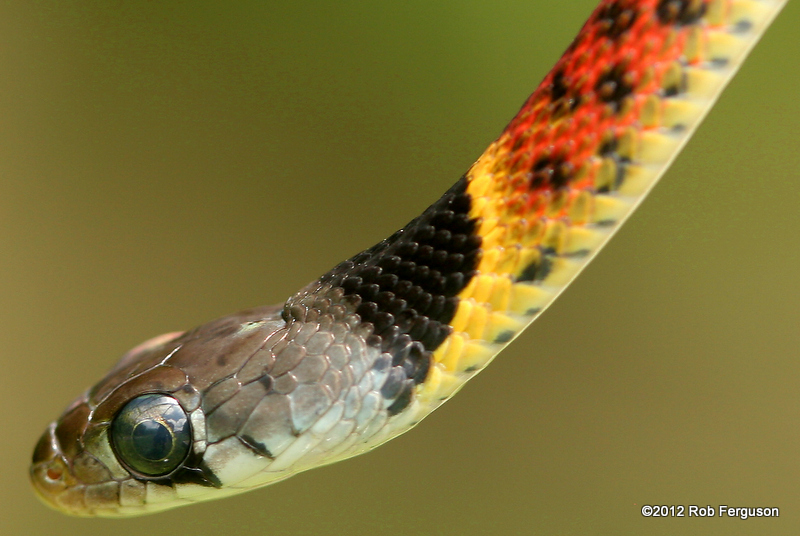Rhabdophis subminiatus
Venomous and Dangerous!


Chiang Mai (© Sjon Hauser) 
Krabi (© Tom Charlton) 
Hong Kong (© Rob Ferguson) 
Nakhon Ratchasima (Thor Håkonsen / Cold Blood)
English name: Red-necked Keelback
Scientific name: Rhabdophis subminiatus
Thai name: งูลายสาบคอแดง (Ngu Lai-Saab Kho Daeng)
Description: To 130cm long. Body is relatively slender. Color is greenish-gray or olive with red and yellow coloration around the neck. Eyes are large. Juveniles sometimes lack the red neck, but have a large black spot on the back of the neck and indistinct black barring on the body.
Similar Species: Yellow-spotted Keelback is less colorful and lacks the characteristic red neck. Juvenile Yellow-spotted Keelbacks lack the large black marking on the back of their neck that juvenile Red-necked Keelbacks have.
Buff-striped Keelback has a characteristic white or cream stripe on the side.
Black-banded Keelback lacks the red color on the body outside of a small pink-to-orange spot on the top of the neck in juveniles
Range: Nepal, Bhutan, Bangladesh and NE India across southeast Asia and southern China east to Hong Kong and south through Indonesia.
Habitat: In moist forests, grasslands, or brushy areas near marshes, ponds, streams, ditches, and rice patties.
Place in the ecosystem: The Red-necked Keelback eats primarily frogs, though it will also feed on fish. The juveniles are eaten by larger snakes, large fish, and birds.
Danger to humans: This snake is not aggressive, but will bit if handled or provoked and can cause adverse affects in humans if it is able to work in its venom. These affects may include headache, nausea, vomiting, and severe renal failure (due to procoagulants).
Conservation status and threats: No known conservation threats over its broader range. There is a historic record for Bangkok, but I know of no recent records and it is possible that its habitat in Bangkok no longer exists due to development.
Interesting facts: The Red-necked Keelback was once thought to be non-dangerous, but several recent cases of snakebite from this species have led to serious hospitalizations. In these cases the snake was allowed to bite for an extended period of time, allowing it to work its rear fangs fully into the hand and release its venom. It is highly recommended that this snake not be handled, and if a bite does occur, make sure the snake is removed immediately and seek medical attention as a precautionary measure.
References:
Ecology Asia: Red-necked Keelback
Severe coagulopathy after a bite from a ‘harmless’ snake (Rhabdophis subminiatus)
Wikipedia: Rhabdophis subminiatus
A Photographic Guide to Snakes and Other Reptiles of Peninsular Malaysia, Singapore and Thailand
A Field Guide to the Reptiles of South-East Asia
where to submit photos of snakes we find to see what they are ?
thaied was able to share with me some photos of a harmless Banded Kukri Snake that had been beaten to death.
Just arrived here in Krabi, Thailand. I was sat on curb outside my hotel awaiting shuttle bus when i seen something moving outta the corner of my eye. The snake was about 3 feet from me, i jumped faster than i thought possible. When my feet hit the ground it turned and moved away from me. I have picture and video of you would be to send.
Just had one in my kitchen, googling it brought me here…..
Neat! Hope you removed it safely, they’re not really dangerous unless you grab them.